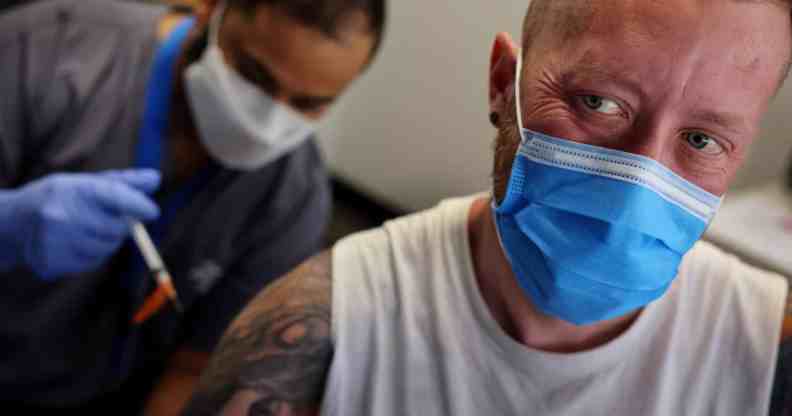Monkeypox: ‘Mounting evidence’ suggests current strain can be sexually transmitted

Monkeypox vaccine shortages have threatened to undermine efforts to curb the virus. (Craig F. Walker/The Boston Globe via Getty Images)
New research suggests the strain of monkeypox involved in the current global outbreak is predominantly sexually transmitted.
As of Wednesday (17 August), there have been more than 35,000 confirmed cases of monkeypox across 92 countries and territories since the beginning of the outbreak in April 2022, according to the World Health Organization (WHO). Most of these are among men who have sex with men.
In the earlier stages of the outbreak, experts insisted there was no evidence that monkeypox was a sexually transmitted virus, and that it was mostly transmitted by skin-to-skin contact, but mounting research is suggesting otherwise.
On Sunday (14 August), Dr Jeffrey Klausner of University of Southern California and Dr Lao-Tzu Allan-Blitz from Brigham and Women’s Hospital in Boston and Harvard published an essay explaining why they believe the virus is largely sexually transmitted.
‘Mounting evidence’
In their essay, which has been submitted to a scientific journal for publication, the two experts admitted that the issue is still up for debate, but listed several reasons for the “mounting evidence that sexual transmission is the most common mode of transmission” of monkeypox.
It claims people most at risk of contracting monkeypox is the same demographic at risk of contracting other sexually transmitted infections, for example those “attending sex-on-site venues, multiple recent sex partners, and condomless receptive anal intercourse”.
Secondly, studies from the UK, the US, Italy and Spain have documented initial lesions “occurring at the genitalia, rectum, and oropharynx”, indicating that these locations are where the virus first entered the body.
Lastly, research has shown that monkeypox DNA can be detected in bodily fluids like semen and saliva. Last month, the UK Health Security Agency (UKHSA) recommended using condoms for 12 weeks after recovering from monkeypox because of the discovery.
But, the authors add, calling the outbreak a sexually transmitted infection is “double edged.”
“The stigma surrounding sexually transmitted infections in gay men and other sex with men limits healthcare seeking and partner-notification behaviours directly subverting our primary means of outbreak control – namely, early identification and behaviour change in infected individuals.
“Furthermore, such stigma can fuel further homophobia, particularly in areas without human rights protections for individuals who engage in same-sex relationships.
“Conversely, failure to appropriately identify and disseminate to the public the predominant mode of transmission will likely perpetuate behaviours that are driving transmission.”
Other experts have spoken on the topic.
Dr Paul Adamson, an infectious disease specialist at the UCLA School of Medicine, told NBC News: “At this point, I’m not sure we can say it is primarily the sexual transmission and not the skin-to-skin contact that also occurs during sex that is contributing to the most transmission during this current outbreak.
“However, emerging data seems to suggest that monkeypox might be more efficiently transmitted sexually.”
He also suggested that the scientific community may be slow to accept monkeypox as a predominantly sexually transmitted virus because of how it has historically been transmitted in countries where the virus is endemic.
“Historically, the primary mode of transmission of monkeypox was through skin-skin contact, though there might have been some suggestion of sexual transmission in prior outbreaks,” he said.
“It takes some time and additional data to overturn our understanding of transmission.”

